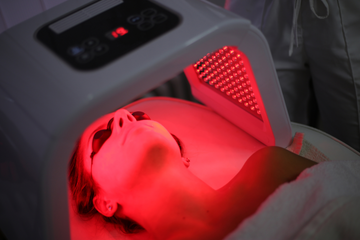Red light therapy is the latest biohacking trend, with treatments available at commercial wellness centers, as well as high-priced red light devices for in-home use. Websites promoting red light therapy claim to “solve” just about every problem, from muscle recovery, to pain management and skin health. The sheer volume of health claims raises skepticism. Are these claims supported by research?
Today’s article will dive into the research on red light therapy and ask important questions, such as:
- What is red light therapy?
- What research supports (or doesn’t support) the health claims?
- What type of research – in vitro, animal studies, or human trials – are companies using to support health claims?
- Is red light therapy just the latest trend, or is there something to it?
If you’re unsure about investing in red light therapy or wonder if red light therapy really works, this article is a must-read.
What is Red Light Therapy?
Light therapy, known as low-level laser (light) therapy (LLLT) or photobiomodulation, involves the spectrum of visible and invisible light identical to what the sun emits between 390 and 1100 nanometers (nm).[1]
Red light is between 620 and 750 nm and is visible to the human eye. The healing power of red light was discovered by accident in 1967 when a Hungarian researcher, Endre Mester, used a ruby (red) laser in rat studies. He noticed that the red light stimulated hair growth and wound healing in the rats. In the 1990s, LED (light-emitting diode) lights replaced lasers, and research on red light’s therapeutic potential began to increase.[2]
Beyond the red light the spectrum is near infrared light, which is invisible to the human eye. It encompasses the spectrum of 810-850 nm.[3]
Humans have evolved in relationship to the sun, so it makes sense that the sun influences the body. Lower wavelengths penetrate the skin very shallowly, while longer wavelengths of light, over 600 nm (including red and near-infrared light), penetrate more deeply. However, there are limits to penetration, with very limited penetration into the human brain compared to animal studies.[1][3]
Red light therapy devices emit red and near-infrared light, allowing for direct exposure to the skin and shallow tissues beneath the skin.
Mitochondria in cells absorb photons from the light, which can activate blood flow, ATP (energy) production, and signaling pathways in cells and tissues. These mechanisms may offer therapeutic potential.[1][4]
Does Red Light Therapy Work?
While much of the earlier research on red light therapy involved understanding the mechanisms through in vivo lab and animal studies, more recent research has been in humans, at least for specific health claims, including skin and performance.
Surprisingly, quite a lot of research is done on red light therapy; we’ll focus on the newer research, human trials, and reviews when available.
Exercise Performance and Recovery
A small 2012 randomized, double-blind placebo-controlled crossover trial looked at red light therapy (red and infrared) light and muscle fatigue. Ten health volunteers received red light treatments or a placebo on four points of the bicep muscle for three minutes before exercise. Each participant received each treatment. The researchers found both the red and infrared therapies improved muscle performance and delayed muscle fatigue.[5]
A 2015 randomized controlled trial also looked at healthy men, over an 8-week training program. There was a control group, a group who only did the training program, and a group who did the training program and red light therapy before each training session. While the exercise groups saw improvements, those who added red light therapy to training had significant increases in muscle thickness (knee extensor muscle) and peak torque over those with exercise alone.[6]
In a 2017 review, researchers reviewed 46 studies like the ones above and compiled the data from 1045 participants and various red light therapy tools on exercise performance. Researchers concluded that red light therapy promotes increases in muscle mass gained after training, and decreases in inflammation and oxidative stress per muscle biopsies.[7]
Skin Health and Anti-Aging
In addition to the exercise benefits, some human research has been done on the benefits of red-light therapy for skin health.
A 2007 randomized controlled trial of 76 people used phototherapy on half their face twice weekly for 4 weeks. The treated side of the faces compared to the untreated side showed:
- Decreased wrinkles
- Increased skin elasticity
- Decreased inflammation[8]
In a 2014 randomized controlled trial, researchers compared 113 subjects receiving twice weekly red light therapy treatments to controls for changes in skin health. Those receiving the therapy saw significant improvements in:
- Skin complexion and feeling
- Skin smoothness
- Collagen density[9]
These studies suggest both red light and near-infrared light have similar benefits. The treatments were well tolerated without adverse effects.[8][9]
More recent research suggests similar benefits, yet the sample sizes in the studies continue to remain small. In a 2023 clinical study, 20 healthy white women received red light therapy treatments twice weekly for 3 months, demonstrating progressive skin improvements and decreased visible signs of aging.[10]
In a review of 13 randomized controlled trials on acne, red light therapy did not perform better than conventional acne treatments.[11]
There are only two trials assessing red light therapy on hair growth (after chemotherapy) with promising results, but more research is needed.[12]
Pain Management
Many red light device companies claim red light therapy supports pain management. However, the research lags behind the human trials we’ve already discussed.
Anecdotal reports of people using red light for pain are plenty. But what does the science actually say? Much of the red light pain research thus far relies on animal models as researchers are trying to discover the pain mechanisms that red light might affect. In clinical trials, red light may exacerbate migraine pain but may have benefits for low back pain and fibromyalgia when placed on the skin above the pain area.[13]
Key Takeaways
Red light therapy is remarkably safe yet controversial (and expensive). Companies that sell red light therapy devices claim their devices fix a wide array of health issues, yet many of the claims lack strong evidence.
The claims with the best evidence of truth include red light therapy for supporting skin health and exercise recovery. Even the research on skin and exercise could benefit from more extensive and longer clinical trials. There is less evidence for pain management, brain injury recovery, and other claims you may see.[3]
While biohacking tools are shiny and fun, focusing on health foundations will take you a long way on your health journey. These foundations include:
- Solid nutrition and optimizing your protein intake
- Exercise and strength training
- Stress management
- Sleep
- Community
As consumers, it’s always important to question health claims, do your own investigation, and seek purchasing from ethical, transparent companies.
References
1. Avci, Pinar et al. “Low-level laser (light) therapy (LLLT) in skin: stimulating, healing, restoring.” Seminars in cutaneous medicine and surgery vol. 32,1 (2013): 41-52.
2. Hamblin, Michael R. “Shining light on the head: Photobiomodulation for brain disorders.” BBA clinical vol. 6 113-124. 1 Oct. 2016, doi:10.1016/j.bbacli.2016.09.002
3. Henderson, Theodore A. “Can infrared light really be doing what we claim it is doing? Infrared light penetration principles, practices, and limitations.” Frontiers in neurologyvol. 15 1398894. 28 Aug. 2024, doi:10.3389/fneur.2024.1398894
4. Powner, Michael B, and Glen Jeffery. “Light stimulation of mitochondria reduces blood glucose levels.” Journal of biophotonics vol. 17,5 (2024): e202300521. doi:10.1002/jbio.202300521
5. de Almeida, Patrícia et al. “Red (660 nm) and infrared (830 nm) low-level laser therapy in skeletal muscle fatigue in humans: what is better?.” Lasers in medical science vol. 27,2 (2012): 453-8. doi:10.1007/s10103-011-0957-3
6. Baroni, Bruno Manfredini et al. “Effect of low-level laser therapy on muscle adaptation to knee extensor eccentric training.” European journal of applied physiology vol. 115,3 (2015): 639-47. doi:10.1007/s00421-014-3055-y
7. Ferraresi, Cleber et al. “Photobiomodulation in human muscle tissue: an advantage in sports performance?.” Journal of biophotonicsvol. 9,11-12 (2016): 1273-1299. doi:10.1002/jbio.201600176
8. Lee, Seung Yoon, et al. "A Prospective, Randomized, Placebo-Controlled, Double-Blinded, and Split-Face Clinical Study on LED Phototherapy for Skin Rejuvenation: Clinical, Profilometric, Histologic, Ultrastructural, and Biochemical Evaluations and Comparison of Three Different Treatment settings." Journal of Photochemistry and Photobiology B: Biology, vol. 88, no. 1, 2007, pp. 51-67. Elsevier, https://doi.org/10.1016/j.jphotobiol.2007.04.008
9. Wunsch, Alexander, and Karsten Matuschka. “A controlled trial to determine the efficacy of red and near-infrared light treatment in patient satisfaction, reduction of fine lines, wrinkles, skin roughness, and intradermal collagen density increase.” Photomedicine and laser surgery vol. 32,2 (2014): 93-100. doi:10.1089/pho.2013.3616
10. Couturaud, Virginie et al. “Reverse skin aging signs by red light photobiomodulation.” Skin research and technology : official journal of International Society for Bioengineering and the Skin (ISBS) [and] International Society for Digital Imaging of Skin (ISDIS) [and] International Society for Skin Imaging (ISSI) vol. 29,7 (2023): e13391. doi:10.1111/srt.13391
11. Wu, Yifan et al. “Application of red light therapy for moderate-to-severe acne vulgaris: A systematic review and meta-analysis.” Journal of cosmetic dermatology vol. 20,11 (2021): 3498-3508. doi:10.1111/jocd.14369
12. Rose, Lucy et al. “Red light therapy for patients with chemotherapy-induced alopecia.” Supportive care in cancer : official journal of the Multinational Association of Supportive Care in Cancer vol. 33,2 137. 1 Feb. 2025, doi:10.1007/s00520-025-09209-y
13. Cheng, Kevin et al. “Mechanisms and Pathways of Pain Photobiomodulation: A Narrative Review.” The journal of painvol. 22,7 (2021): 763-777. doi:10.1016/j.jpain.2021.02.005





